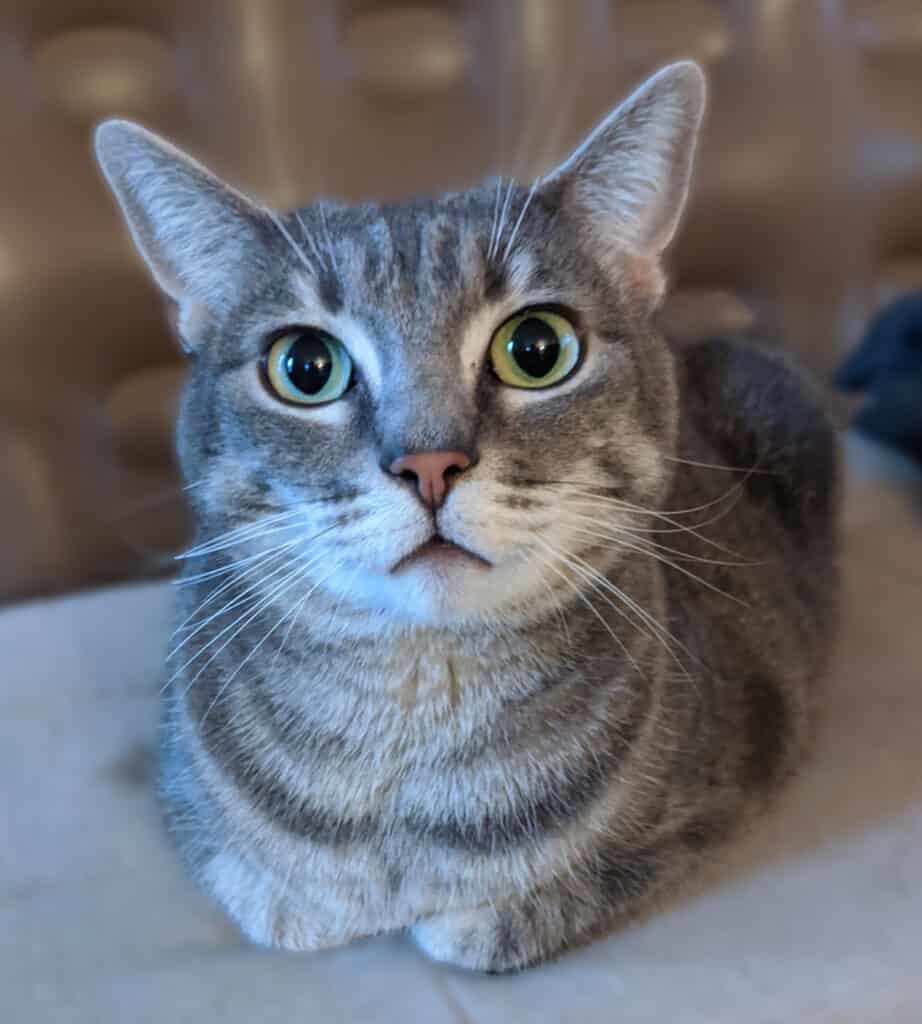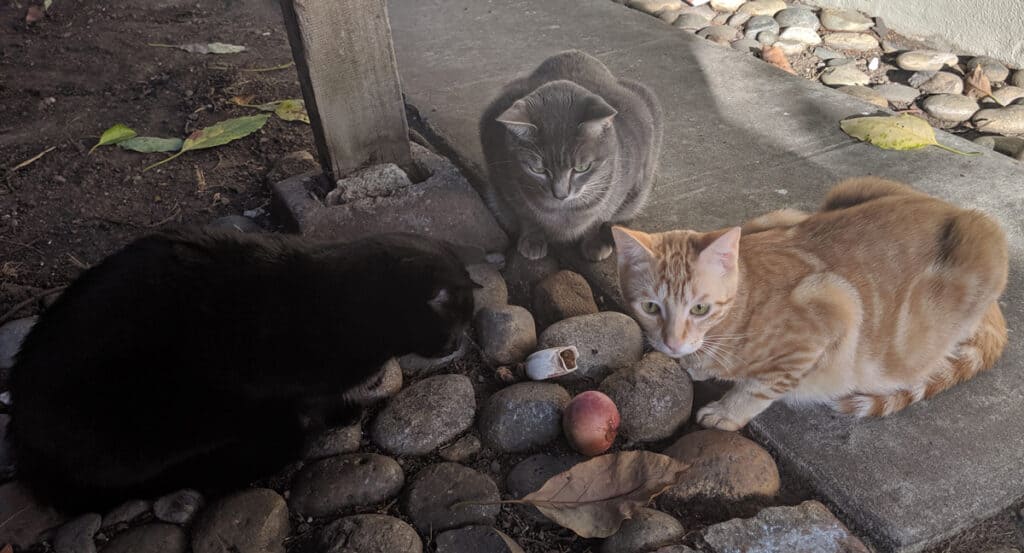Cats are crepuscular which means that they are most active at dawn and dusk. Cats have evolved to be able to hunt in the dim lighting at this time of day. The size and shape of their eyes as well as photoreceptors help these felines to see better in the dark.
So, what are the adaptions that help cats to see better in low-lighting?
Cats Have Large Eyes
A cat’s very large, round eyes are part of what endears these furry creatures to us. These large eyes are an adaption that allows the cat to see better in low-light conditions.

A camera lens opens up its aperture to its widest setting in order to let in as much light as possible. A cat’s pupil’s serve a similar purpose. A cat’s pupil expands and contracts depending on how much environmental light is available.
In bright sunlight, a cat’s pupils will contract to form a very narrow vertical opening. This helps to protect the cat’s retina from sun damage while still allowing a large depth of field.

In low-light conditions, the pupil will expand, almost to the edges of the surface of the eye. This expansion allows the maximum amount of light to enter the eye. Compared to humans, cats see about 6-8 times better in low-light conditions.
Why Do Cats Eyes Glow in the Dark?
Cats are which are equipped with special reflectors that bounce light from objects behind them into their eyes. This reflective layer is known as the tapetum lucidum and serves to increase the eye’s sensitivity to dim light. Tapetum lucidum is a Latin phrase that translates to “bright or shining tapestry.”
Also known as “eyeshine”, tapetum lucidum is always why a cat’s eyes glow when light from a camera flash or flighlight is shone at them.

At times cats’ eyes almost look like they glow because mirrors positioned on their retina act as reflectors to bounce light back and enhance what’s already been absorbed. This is made possible due to the presence the tapetum lucidum. Generally, the cat’s eyes glow yellow-orange or yellow-green and it all depends on the color of the iris.
Can cats see in the dark?
Cats are uniquely adapted to see well in low-light conditions, making them excellent nocturnal predators. While cats can’t see in complete darkness, their vision is far superior to that of humans in dimly lit environments.
Humans and cats have quite a few differences but there is one in particular that makes a big difference: the retina. This is where photoreceptors are, that process incoming electromagnetic radiation which is then transferred to the brain so it can be seen as images.
Understanding how photoreceptors in the cat eye work can be a bit difficult because they come in two different types: rods and cones. Rods are responsible for seeing objects when there isn’t much light around and detecting shades of gray. Cones are generally thought to be mainly responsible for their ability to see colors, but it turns out that there is more to their ability than people once believed.
When we see at the number of cones and rods in the cats, a cat has less number of cones and more rod receptors. This is one of the reasons cats can see well at night.
Cats have a reflective layer behind their retinas that intensify the light from their eyes and make them shine brighter in low-light photographic conditions. This is why they appear extra bright, especially when being photographed near or inside dark areas.
There are many animals that have developed natural eye-shine, usually in the form of reflecting light. This helps them detect changes in light when they need it, like during dawn and dusk, or when there are no other sources of light around. This can be helpful when foraging for food at night or looking out for predators.
When you stare into the eyes of a cat, one thing becomes very clear: their pupils are fascinating. Unlike our own eye pupils which simply shrink or enlarge with the presence of light, cats’ pupils open up and contract by varying degrees depending on the brightness of their environment.
They also have more of a special kind of light-sensing cell in the back of their eyes than we humans do call rods. Rods are especially handy for capturing low-level lighting so that cats can instantly see you approach them from behind or find that hidden mouse scurrying across your kitchen floor in the middle of the night.
How Well Do Cats See in General?
The average human eye only perceives 180 degrees of what’s from left to right and up and down, but cat eyes expand their visual range all the way up to 200 degrees.
Are Cats Near-Sighted Or Far-Sighted?
Whether a cat is near-sighted or far-sighted depends on the environmental conditions the cat was raised in. The light and visual conditions that a cat was raised in affect the development of the muscles that control vision strength. Switching between focusing on objects that are near versus far away is difficult due to the size of a cat’s eyes.
Therefore, most indoor cats tend to be near-sighted (myopia), whereas most outdoor cats are far-sighted.

Visual Acuity of Cats
The average human’s visual acuity is 20/20, just close enough to get a clear picture without having to squint, which would otherwise inhibit their sight from all but the closest objects that may be lurking in the distance. On the other hand, the cat’s vision is 20/100 which means a cat needs to be at 20 feet to see what a human can see from 100 feet.
Cats are close-sighted. This means they can’t focus on objects that are within a foot of their eyes. Instead, cats use their whiskers found on their face and legs to sense objects, especially prey, near them.
What Colors Can Cats See?
In the past, there were quite a few misconceptions about how cats perceived the world around them. Common rumors abounded that cats were colorblind or only saw in shades of gray and even worse, didn’t see anything at all.
Like humans who have trichromatic vision, cats have up to three types of cones that allow them to differentiate shades. Cats are able to see some colors. Cats can distinguish between red, blue, and yellow lights, as well as red and green lights.
Cats are also unable to see the hues and saturation of colors that we humans can see.
Conclusion
Cats have special features that allow them to see in the dark. They can see better than humans in the dark because their eyes have some special features.
Cats also have a wider field of view than humans and they have more rods at the back of the eye which are used in dim light. This allows them to see better in dim light than humans.
Cats also have a reflective layer behind the retina called the tapetum lucidum. This layer reflects light to the rods, causing them to be stimulated a second time, providing a brighter image.
Read next: Cat Ownership Linked to a Positive Effect on Brain Health
References
Bergmanson, J. P., & Townsend, W. D. (1980). The morphology of the cat tapetum lucidum. American Journal of Optometry and Physiological Optics, 57(3), 138-144. DOI: 10.1097/00006324-198003000-00002
Clark, D. L., & Clark, R. A. (2016). Neutral point testing of color vision in the domestic cat. Experimental Eye Research, 153, 23-26. https://doi.org/10.1016/j.exer.2016.10.002
Foote, B. (2022, April 11). Why do cats’ eyes glow in the dark? The Conversation. https://theconversation.com/why-do-cats-eyes-glow-in-the-dark-179531
Guenther, E., & Zrenner, E. (1993). The spectral sensitivity of dark-and light-adapted cat retinal ganglion cells. Journal of Neuroscience, 13(4), 1543-1550.doi: 10.1523/JNEUROSCI.13-04-01543.1993






